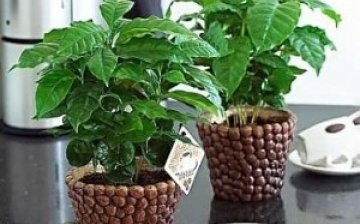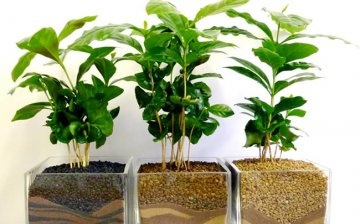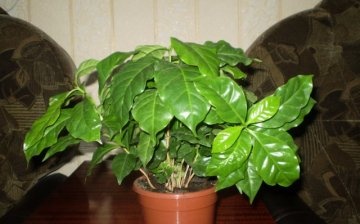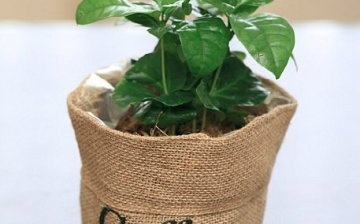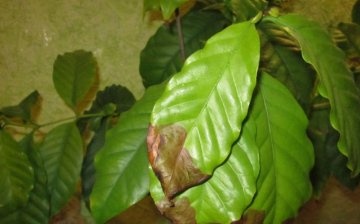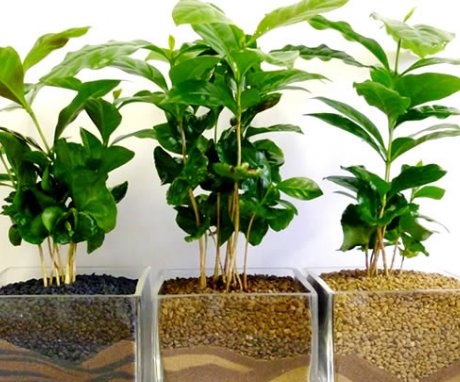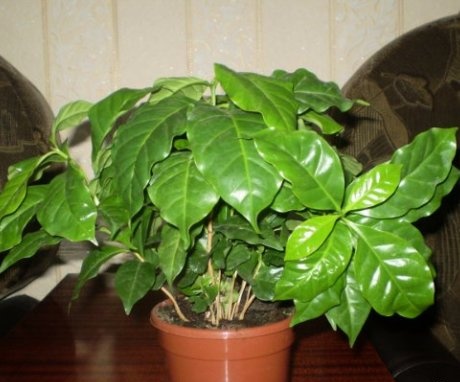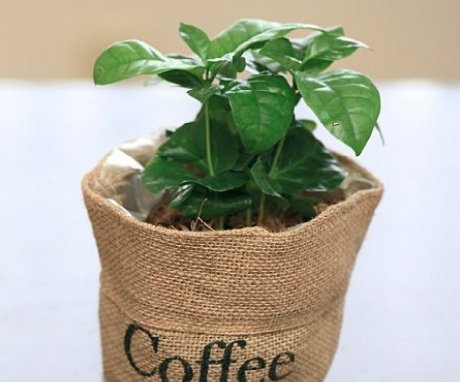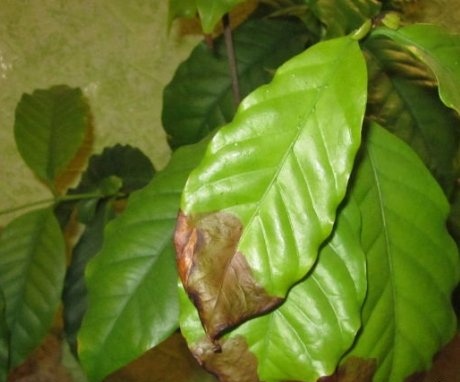Coffee tree: care and transplant
The coffee tree is an exotic plant. It is very thermophilic and is grown at home as decorative. Do not grow coffee outdoors. A tree at home grows no more than 2 m in height. With proper care, you can collect a small amount of fruits and grains from it, but you will not be able to grow coffee plantations. Despite the exoticism, growing an indoor coffee tree is not as difficult as it seems at first glance.
Content:
- Indoor coffee tree: description
- Houseplant Care Tips
- Boarding and transfer: terms and rules
- Diseases and pests: control and prevention
Indoor coffee tree: description
The coffee tree belongs to the Madder family. Africa is considered the homeland of this plant, but coffee also grows well in South America, in Cuba. The plant is very thermophilic, evergreen.
A coffee tree, which is considered expensive and troublesome to care for, actually grows well in an apartment environment (if you choose dwarf varieties), and no more maintenance is required than for any other indoor plant. As a rule, only small domestic trees are grown in Russia for decorative purposes.
If the rules are followed, they bear fruit, but in very small quantities.
The history of coffee goes back to the 12-13th century. Even then, the coffee drink was popular and is considered a must at many ceremonies.
Features of the structure of the plant:
- The homemade coffee tree looks like a small shrub with dense dark green leathery leaves that are slightly wavy at the edges.
- The leaves are arranged in tiers.
- The flowers of the tree are small, white, collected in small inflorescences that resemble an umbrella.
- The fruit of the coffee is not a large green berry. When the fruit is ripe, the berry turns bright red. Inside the berry there are 2 seeds about 1 cm in size.
- The coffee tree does not bloom right away. Depending on the variety, you need to wait from 2 to 6 years.
All parts of the coffee tree contain caffeine, which helps repel pests. It is believed that the coffee tree helps cleanse the air of heavy metals, energizes a person, and helps to strengthen the nervous system.
The following types of coffee trees can be grown at home:
- Arabian coffee. This is a favorite variety of many flower growers. The plant reaches a height of no more than 2 m. The leaves are slightly elongated, the flowers are white, small and very fragrant. It can bloom several times a year. The fruit is small, red, with 2-3 seeds inside. This variety has several varieties. The view called Nana is especially small and suitable for apartments.
- Liberian coffee. This variety is larger, taller with large leaves (up to 40 cm). Due to its size, it is not often grown in apartments. The flowers are white, the fruits are yellowish-red with large seeds.
- Robusta. Low grade. The leaves are bright green, with veins and a small downy. The flowers are white, fragrant.
Houseplant Care Tips
Caring for a coffee tree is not much different from standard caring for any other indoor plant. The flowering of the coffee tree can be delayed if the maintenance is not correct.
To show off your own coffee beans, you need to try to provide the plant with the most comfortable conditions:
- Lighting... Coffee loves a lot of light, but not direct rays, but diffused light. In winter, it is necessary to provide the plant with additional artificial lighting. Bright sun can damage a young plant, and a lack of light leads to slower growth, lack of flowering and fruiting.
- Temperature. Coffee is a heat-loving plant, but the plant does not like heat and stuffiness. Optimal growing conditions coffee the air temperature is not higher than 24 degrees. In winter, the plant needs to be allowed to rest, it slows down its growth, so it is advisable to lower the temperature to 15 degrees. Lower temperatures are not recommended as coffee does not tolerate cold as well as heat.
- Watering... Water the plant as needed. The soil in the pot should always be slightly damp, but not muddy or dry. In the summer they water more often, the water should be soft, at room temperature. In winter, watering is reduced, but still water the tree periodically so that the soil does not dry out.
- Humidity. The coffee tree loves moist air. To maintain a sufficient level of humidity, you can use a humidifier, a tray of water, and regular spraying. It is also necessary to wipe the dust off the leaves regularly. With a lack of moisture, the tips of the leaves begin to dry out and curl up.
- Top dressing... Coffee needs additional dressing in spring and summer, when there is a period of active growth and flowering. You can feed the plant during this period every 2 weeks. As a top dressing, a complex mineral fertilizer is suitable. For best results, it is recommended to alternate organic and mineral fertilizers... From the second half of autumn until next spring, you do not need to feed the plant.
- Transfer. The coffee tree grows well, so at a young age you need to replant it every year, choosing a larger pot. It is undesirable to disturb adult plants unnecessarily.
Boarding and transfer: terms and rules
Growing a coffee tree is no more difficult than a lemon tree if you know the basic rules and features. The easiest way to grow a tree is from coffee beans (not roasted, of course). The plant needs to be transplanted regularly as it grows.
Compliance with the rules of planting and transplanting guarantees good growth and survival of the tree:
- You can find a grain of coffee in a store (gardening) or ask for a seed from the owner of this tree.
- A coffee seed has a very dense shell, so the grain must be soaked in a solution of hydrochloric acid or simply filed a little to destroy the shell, otherwise the seed will not germinate.
- Also, the seed is soaked in a growth stimulator. A similar drug can be found in stores or ordered online.
- When planting, the soil should be slightly moist, loose. The seed does not go deep into the soil. The pot with the planted seed is placed on the windowsill in the brightest place. There is no need to create greenhouse conditions, coffee grows well. The temperature should be above 20 degrees.
- Soil for planting and transplanting plants can be purchased at a specialized store or made on your own. The coffee tree loves acidic soils with peat, sand, humus in equal proportions. You can add some chopped charcoal.
Cuttings a more convenient method of propagation, since the cutting gives roots faster, grows in width and begins to bloom earlier. Cuttings are cut from a selected mature tree. Each stalk must be at least 8 cm long and have 2 buds. Each stalk is planted in a separate container with a prepared moistened substrate. They must be placed in a warm place (temperature not lower than 27 degrees) with sufficient humidity, or covered with a film that must be periodically opened.
Once the cuttings are rooted, they can be planted in permanent pots.It is better to choose a pot a little larger, since the plant grows strongly. When transplanting, a fresh substrate (slightly damp) is prepared in a larger pot. The soil in the old pot must be moistened, the soil must be slightly loosened and the plant must be carefully removed along with the earthy clod. The tree is placed in a new pot, covered with soil. You can water it lightly. Don't forget about drainage.
Diseases and pests: control and prevention
There are peculiarities of caring for a coffee tree. It can hurt from improper care more often than from pests, since caffeine repels many insects.
For example, a coffee tree does not like to be disturbed, moved and rearranged - changing the rotation can lead to foliage falling off.
Most often, the following diseases and pests are found in the coffee tree:
- Sooty fungus. Sooty fungus most often affects young and weak plants. It occurs if the room is poorly ventilated or the air humidity is too high. The fungus clogs the pores, disrupts the process of photosynthesis, as a result, the leaves turn brown and gray. You need to fight the fungus with ventilation and insecticides.
- Spider mite. It is a small parasitic insect that feeds on the leaves of the plant. It secretes a substance that entangles leaves and stems and resembles a cobweb. The pest can be removed mechanically, washed the leaves with a solution of laundry soap, decoction of citrus peels.
- Shield. Small insects that infect indoor flowers. They leave small gray spots on the leaves. You can see the insects themselves on the stems and in the soil. You can fight the scabbards by mechanical cleaning, spraying with disinfecting solutions.
- Leaf spot. A fungal disease that is virtually untreatable. First, spots appear, then the leaves quickly fall off, and the tree dies. Damaged leaves and shoots must be removed.
- Rust. This is a fungal disease associated with improper care and high soil moisture. The leaves begin to turn yellow, brown spots appear on them. Some varieties have immunity to this disease. You can fight the fungus with the help of special preparations and spraying.
- Leaves bacterial infection. Usually, bacterial infection begins through the damaged trunk. The leaves on the plant begin to turn yellow, dry out and fall off. To get rid of the disease, the affected trunk must be cleaned and treated with disinfecting drugs.
The coffee tree can become infected from other houseplants, so they should be checked regularly for spots and larvae. With proper care, the likelihood of illness is minimized.
More information can be found in the video:



